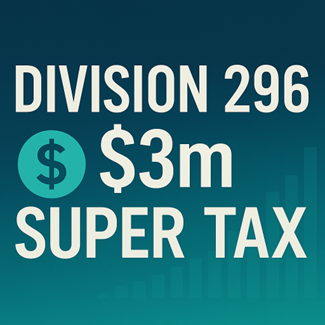$3m Super Tax - Division 296 Reality Check
$3m Super Tax - Division 296 Reality Check
There remains a lot of confusion swirling around how the draft Division 296 legislation will impact Australians with super balances over $3 million. Many clients who won’t be impacted by the tax have expressed interest in how it works, so let's work through a real example to see what the tax burden looks like.
The Common Misconceptions
First, the tax applies to individuals, meaning a couple could collectively have $6 million in superannuation (being $3m each) and not be subject to the tax.
Many people believe that if you have $3.5 million in your super fund – being $500,000 above the $3 million threshold - you'll pay 30% tax on that entire amount. Using this logic, someone would face a tax bill of $150,000. No wonder people are concerned.
But this isn't how Division 296 is proposed to work.
How the Calculation Really Works
The legislation takes a more nuanced approach. Let's say your super balance grows from $3.2 million to $3.5 million in one year without any contributions.
Here's the step-by-step calculation:
• The excess amount is $500,000 ($3.5m - $3m)
• This represents 14.29% of your total balance ($500,000 ÷ $3.5m)
• The tax applies only to your earnings which is both income and capital growth (in this case, $300,000)
• The calculation becomes: 14.29% × $300,000 × 15% = $6,429
That's a significant difference from the $150,000 figure many people expect.
It's important to note that this calculation method accounts for various scenarios. For instance, if you had made concessional super contributions during the year, these would be factored out before determining your earnings. Let's say you contributed $30,000 during the year. In this case, your earnings would be calculated as $270,000 ($300,000 total growth minus $30,000 contributions). The tax calculation would then use this lower earnings figure, resulting in an even smaller tax liability.
This proportional approach ensures you are only taxed on the portion of your earnings that relate to the excess balance, and at a rate of 15%, not 30%.
It's worth noting that the $3 million threshold isn't planned to be indexed, and the ATO will send notices for any tax payable – just like they currently do for Division 293 tax liabilities (where your annual taxable income exceeds $250,000 and you need to pay an additional 15% tax on your concessional super contributions).
Whilst Division 296 will certainly affect those with substantial super balances, the real-world impact may be less than you initially feared. The key is getting past the headlines and understanding how the mathematics actually work.
We still await the final Division 296 legislation but for people who will be impacted, how to respond depends on each person’s situation. For people with illiquid assets in the super fund – like a commercial property – it could present a significant issue. But for people with highly liquid portfolios – like Lorica Partners clients – in most cases the best strategy from a household perspective will be to do nothing.
Author: Rick Walker

